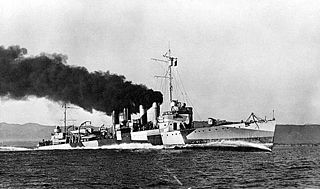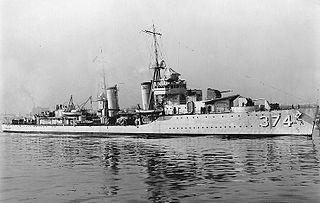Design and construction
Chew was one of 111 Wickes-class destroyers built by the United States Navy between 1917 and 1919. She, along with seven of her sisters, were constructed at Union Iron Works shipyards in San Francisco, California using specifications and detail designs drawn up by Bethlehem Steel.
She had a standard displacement of 1,060 tonnes (1,043 long tons; 1,168 short tons) an overall length of 314 feet 5 inches (95.8 m), a beam of 31 feet 9 inches (9.7 m) and a draught of 8 feet 6 inches (2.6 m). On trials, Harding reached a speed of 35 knots (65 km/h; 40 mph). She was armed with four 4"/50 caliber guns and twelve 21-inch (533 mm) torpedo tubes. She had a regular crew complement of 113 officers and enlisted men. She was driven by two Curtis steam turbines powered by four Yarrow boilers.
Specifics on Chew's performance are not known, but she was one of the group of Wickes-class destroyers designed by Bethlehem Steel, built from a different design than the 'Liberty type' destroyers constructed from detail designs drawn up by Bath Iron Works, which used Parsons or Westinghouse turbines. The non-'Liberty' type destroyers deteriorated badly in service, and in 1929 all 60 of this group were retired by the Navy. Actual performance of these ships was far below intended specifications especially in fuel economy, with most only able to make 2,300 nautical miles (4,300 km; 2,600 mi) at 15 knots (28 km/h; 17 mph) instead of the design standard of 3,100 nautical miles (5,700 km; 3,600 mi) at 20 knots (37 km/h; 23 mph). The class also suffered problems with turning and weight.
Chew was the first and only ship commissioned in the U.S. Navy named for Samuel Chew, who had been a Continental Navy officer killed in the Revolutionary War.
Service history
Chew was launched on 26 May 1918 out of San Francisco, sponsored by F. X. Gygax. She was commissioned on 12 December 1918.
She sailed for the East Coast of the United States on 21 December 1918, and arrived in port at Newport, Rhode Island on 10 January 1919. After brief repairs at port in New York City, New York and refresher training at Guantanamo Bay Naval Base, she cleared New York on 28 April and embarked as an escort during the first transatlantic seaplane flight, made by Curtiss NC-4 aircraft. Following this duty, she visited to the Azores, Gibraltar, Malta, and Constantinople before returning to New York on 5 June. After repairs, she steamed for San Diego, California, leaving New York on 17 September and arriving in San Diego on 12 October. Beginning on 19 November 1919, she was placed in reduced commission, operating only infrequently with Naval reservists of Reserve Division 10 until she was placed out of commission on 1 June 1922.
At a part of the mobilization effort preceding the U.S. entry into World War II, Chew was recommissioned on 14 October 1940, assigned to Defense Force, 14th Naval District. She arrived at Pearl Harbor on 17 December 1940 which she made her home port. She spent the next year conducting patrols and had training duty from Pearl Harbor. She was assigned to Destroyer Division 80, with sister ships Allen, Ward, and Schley.
On the morning of 7 December 1941, Chew was moored in Berth X-5, alongside Allen and the decommissioned Baltimore, which was being used for storage. At the outbreak of the attack on Pearl Harbor by the Empire of Japan that morning, Chew brought one of her 3"/23 caliber guns online and began firing at 08:03, under the command of her executive officer. At 08:11, two of her .50 caliber machine guns were also brought online and began firing. The 3-inch (76 mm) gun scored one Japanese aircraft shot down and two damaged, and the machine guns observed no hits. Chew maintained continuous fire from these weapons until 09:34, when the last of the Japanese aircraft departed. She then got underway and began patrolling for Japanese submarine activity, just southwest of the port entrance buoy. She pinged eight possible contacts and dropped 28 depth charges, which her commander, H. R. Hummer, Jr., reported two Japanese submarines destroyed. [8] Subsequent evidence does not suggest Chew struck any Japanese submarines. In the chaos of the attack, a number of Chew crew members also disembarked and came aboard nearby battleship Pennsylvania, which was in drydock, to assist in manning guns, forming ammunition trains, and fighting fires. Aboard Pennsylvania, two Chew crewman were killed in defending the ship, Seaman Second Class Matthew J. Agola and Fireman Third Class Clarence A. Wise.
From 1941 through the end of World War II, Chew operated out of Pearl Harbor on patrol. She took on periodic escort duties among the Hawaiian Islands and on training duty for submarines. She made occasional trips to San Francisco and Seattle escorting convoys and screening for other Navy ships, inter-island escort, and submarine training duty. Following the end of the war, she departed Pearl Harbor on 21 August 1945 and arrived at Philadelphia 13 September. She was decommissioned there on 10 October 1945, and sold for scrap on 4 October 1946. Chew received one battle star for World War II service.
The ship's bell survived the scrapping and sold to private owner. [11]

USS New York (BB-34) was a United States Navy battleship, the lead ship of her class. Named for New York State, she was designed as the first ship to carry the 14-inch (356 mm)/45-caliber gun.

USS Maryland (BB-46), also known as "Old Mary" or "Fighting Mary" to her crewmates, was a Colorado-class battleship. She was the third ship of the United States Navy to be named in honor of the seventh state. She was commissioned in 1921, and serving as the flagship of the fleet, cruised to Australia, New Zealand, and Brazil.

USS Colhoun (DD-85/APD-2) was a Wickes-class destroyer in the United States Navy during World War I and later redesignated APD-2 in World War II. She was the first Navy ship named for Edmund Colhoun.

USS Leary (DD-158) was a Wickes-class destroyer in the United States Navy during World War II. She was named for Lieutenant Clarence F. Leary, posthumously awarded the Navy Cross in World War I.

USS Ward was laid down as a 1,247-long-ton (1,267 t) Wickes-class destroyer in the United States Navy during World War I, later converted to a high speed transport in World War II. She was responsible for the first American-caused casualties in the Pacific in World War II when she engaged and sank a Japanese midget submarine before Japanese aircraft arrived in the attack on Pearl Harbor, killing both crewmen on board.

The Mahan-class destroyers of the United States Navy were a series of 18 destroyers of which the first 16 were laid down in 1934. The last two of the 18, Dunlap and Fanning, are sometimes considered a separate ship class. All 18 were commissioned in 1936 and 1937. Mahan was the lead ship, named for Rear Admiral Alfred Thayer Mahan, an influential historian and theorist on sea power.
USS Allen (DD-66) was a Sampson-class destroyer of the United States Navy launched in 1916. She was the second Navy ship named for Lieutenant William Henry Allen (1784–1813), a naval officer during the War of 1812. She was the longest-serving destroyer on the Naval Vessel Register when she was sold in 1946 and was one of the few ships in the US Navy during World War II which was completed during World War I.

The fourth USS Dale (DD-353) was a Farragut-class destroyer in the United States Navy during World War II. Dale received 14 battle stars for World War II service. She was named for American Revolutionary war hero Richard Dale.

The Clemson class was a series of 156 destroyers which served with the United States Navy from after World War I through World War II.

The Wickes-class destroyers were a class of 111 destroyers built by the United States Navy in 1917–19. Along with the 6 preceding Caldwell-class and 156 subsequent Clemson-class destroyers, they formed the "flush-deck" or "four-stack" type. Only a few were completed in time to serve in World War I, including USS Wickes, the lead ship of the class.

USS Mahan (DD-102) was a Wickes-class destroyer built for the United States Navy. Commissioned in 1918, Mahan was a flush deck destroyer, and the first ship to be named for Rear Admiral Alfred Thayer Mahan. Her main battery consisted of four 4-inch/50 caliber guns.

USS Breese (DD-122) was a Wickes-class destroyer in the United States Navy during World War I, and later redesignated, DM-18 in World War II. She was the only ship named for Captain Kidder Breese.

USS Ramsay (DD-124) was a Wickes-class destroyer in the United States Navy during World War I, reclassified as DM-16 during World War II and again reclassified as AG-98. She was the first ship named for Rear Admiral Francis Ramsay.

The second USS Blakeley (DD–150) was a Wickes-class destroyer in the United States Navy, named for Captain Johnston Blakeley.

USS O'Flaherty (DE-340) was a John C. Butler-class destroyer escort built for the United States Navy during World War II. She was named for Ensign Frank Woodrow O'Flaherty, a pilot who posthumously received the Navy Cross for his actions at the Battle of Midway.
USS Semmes (DD-189/AG-24) was a Clemson-class destroyer in the United States Navy during World War II. She was the first Navy ship named for Commander (USN), Rear Admiral (CSN), Brigadier General (CSA) Raphael Semmes (1809–1877).

USS Mahan (DD-364) was the lead ship of the United States Navy's Mahan-class destroyers. The ship was named for Rear Admiral Alfred Thayer Mahan, a 19th-century naval historian and strategic theorist. Her design ushered in major advances over traditional destroyers. Among them were a third set of quadruple torpedo tubes, protective gun shelters, and emergency diesel generators. Along with a steam propulsion system that was simpler and more efficient to operate.

USS Tucker (DD-374) was one of 18 Mahan-class destroyers built for the United States Navy and was commissioned in 1936. Tucker's main battery consisted of five dual-purpose 38 caliber 5-inch guns.

USS Carpenter (DD/DDK/DDE-825) was a Gearing-class destroyer of the United States Navy, named for Lieutenant Commander Donald M. Carpenter (1894–1940).

USS Oberrender (DE-344) was a John C. Butler–class destroyer escort built for the United States Navy during World War II. She was named for Lieutenant Commander Thomas Olin Oberrender Jr., the engineering officer of the light cruiser USS Juneau, who was killed when that ship was torpedoed and sunk during the Naval Battle of Guadalcanal in 1942.

















